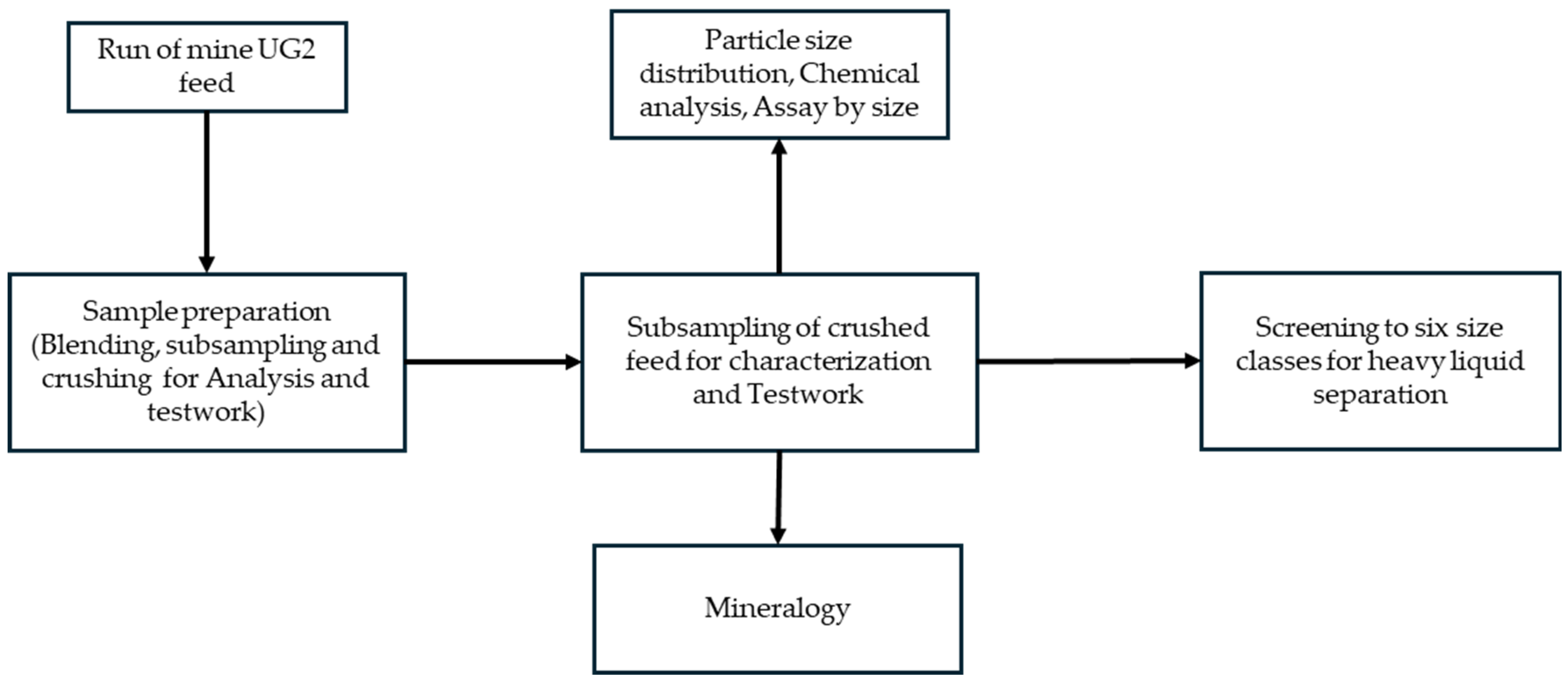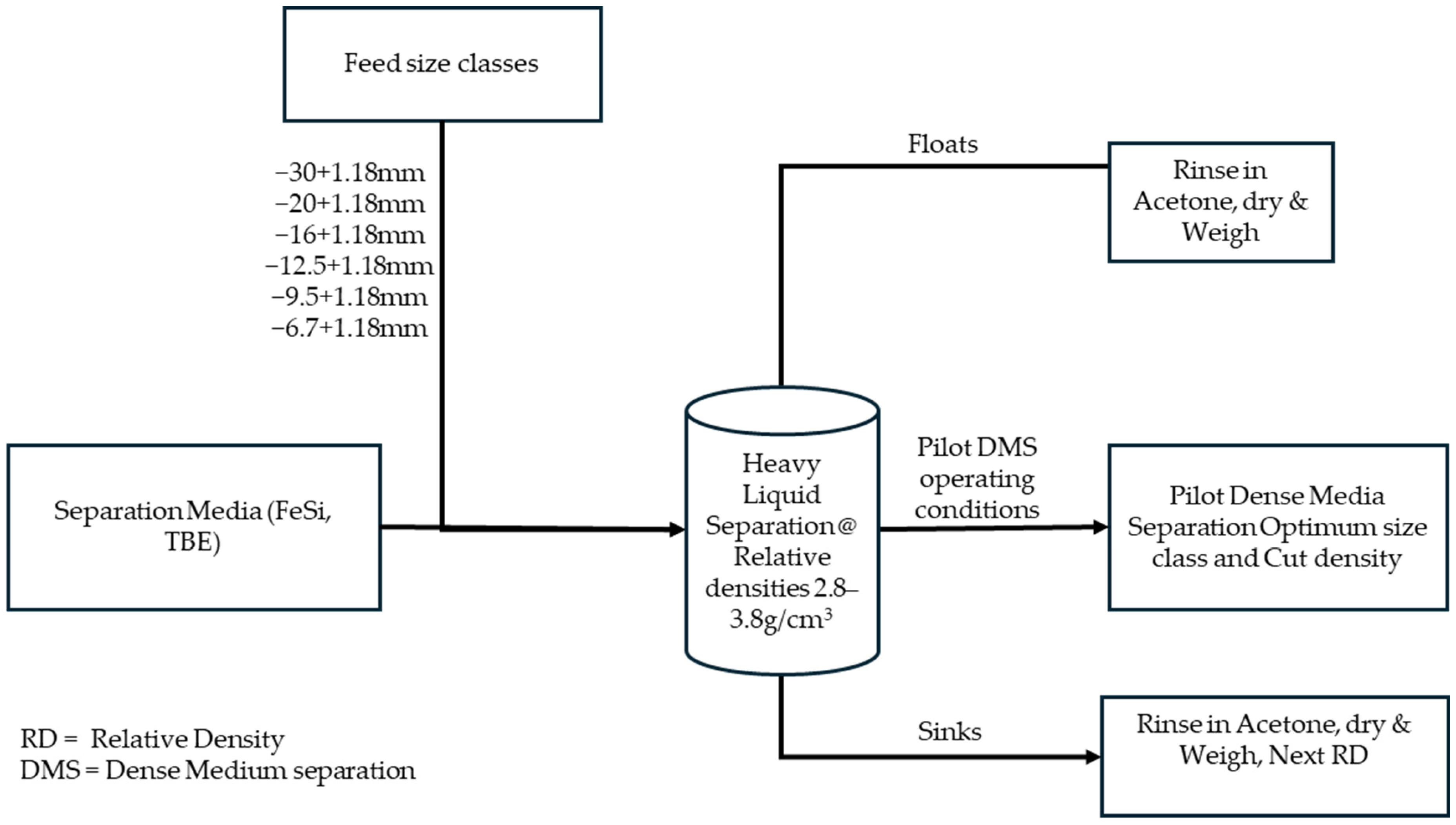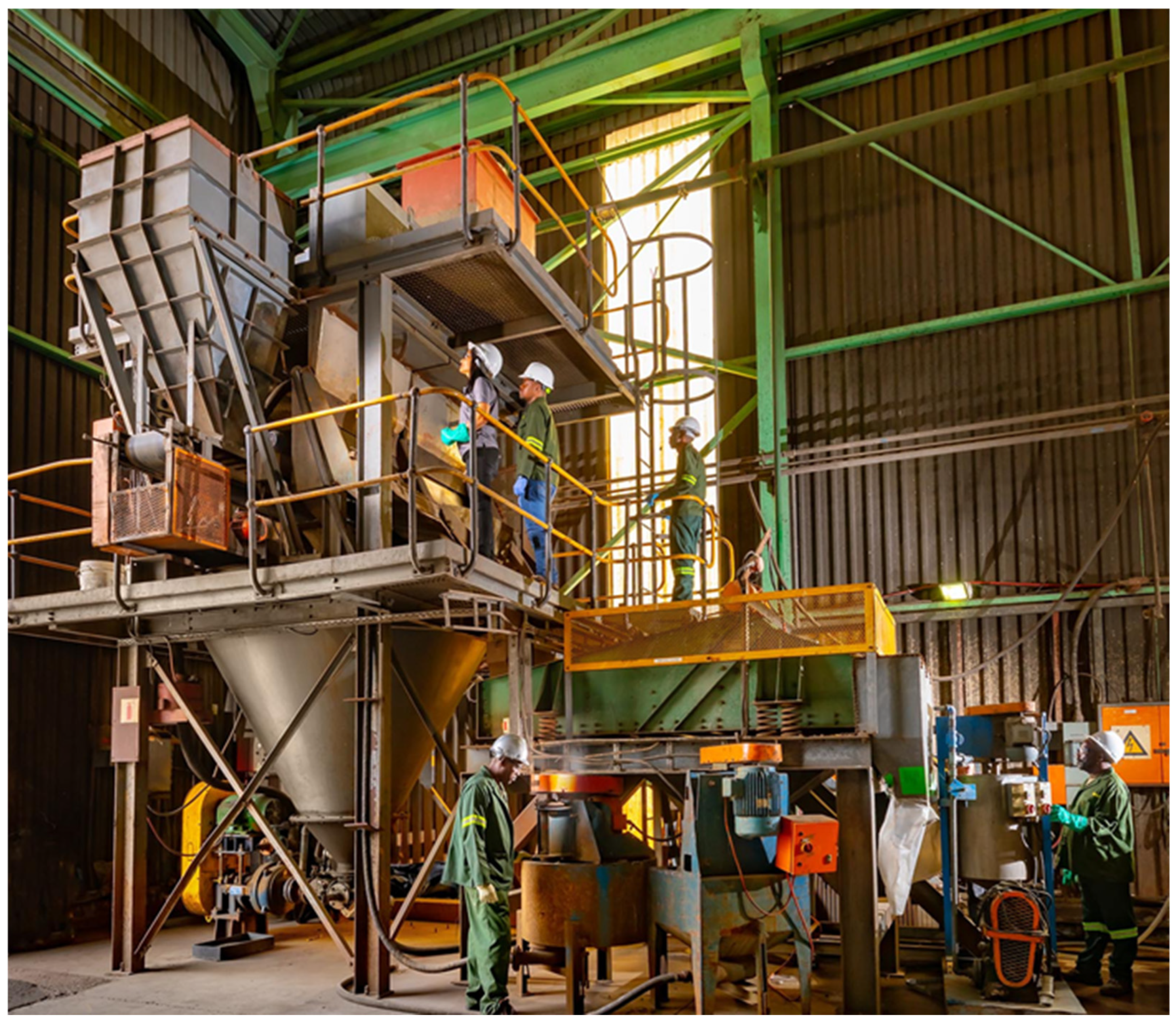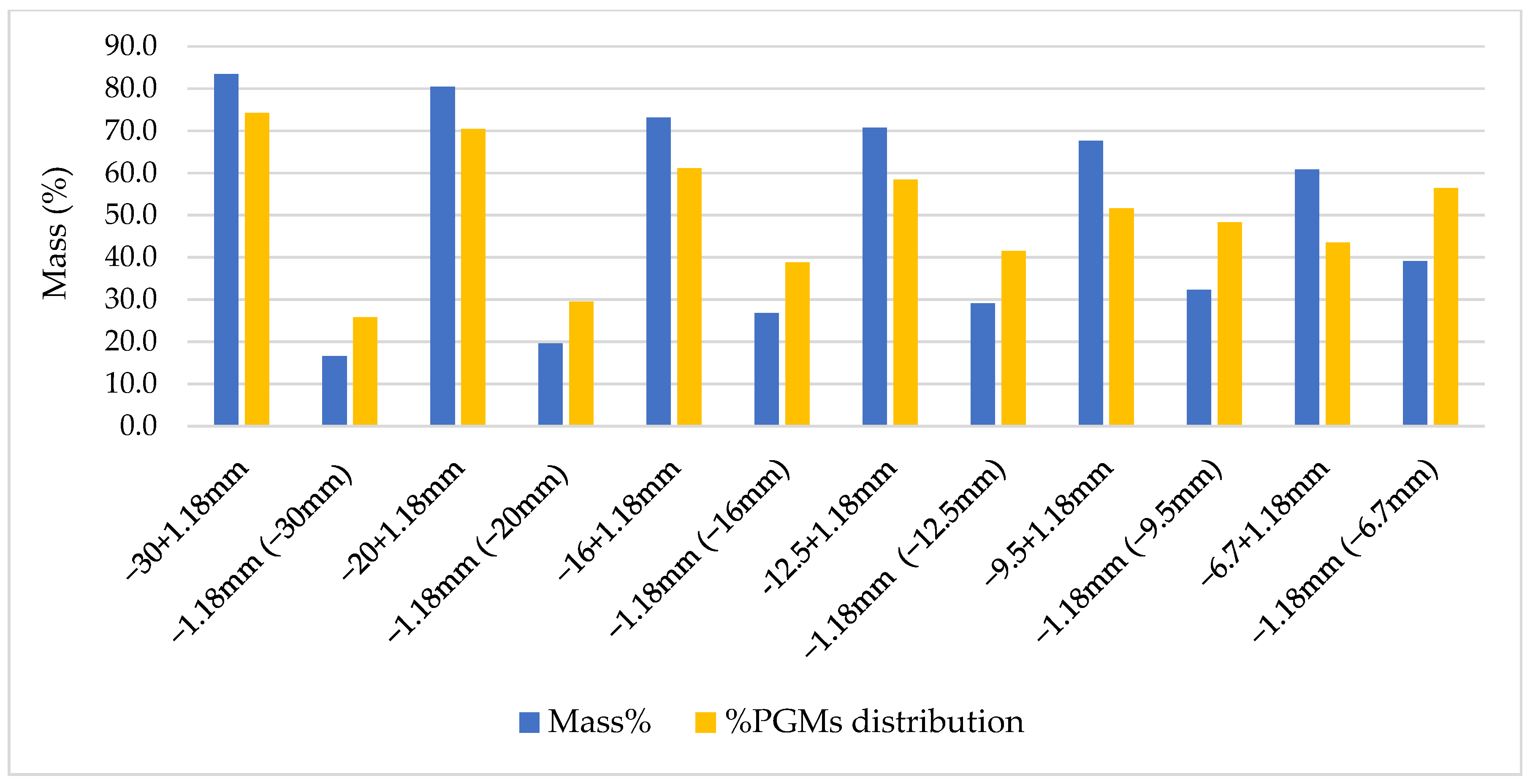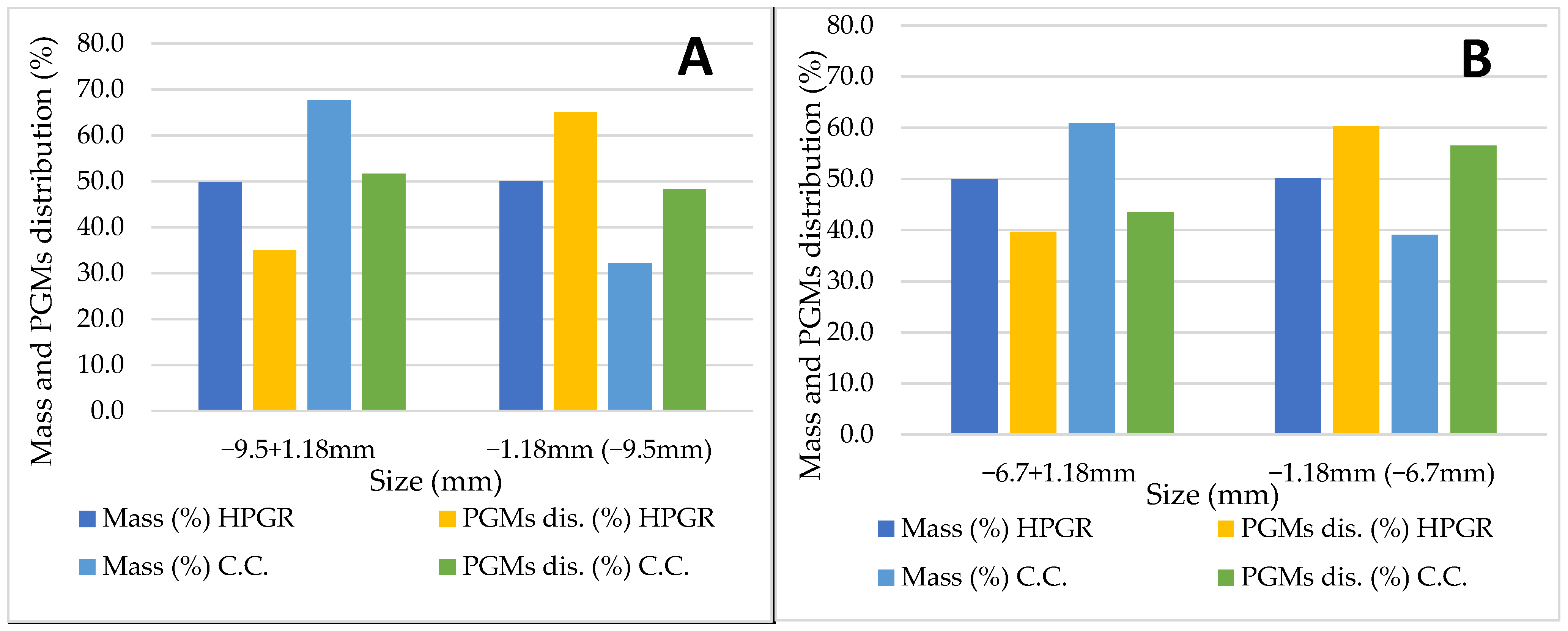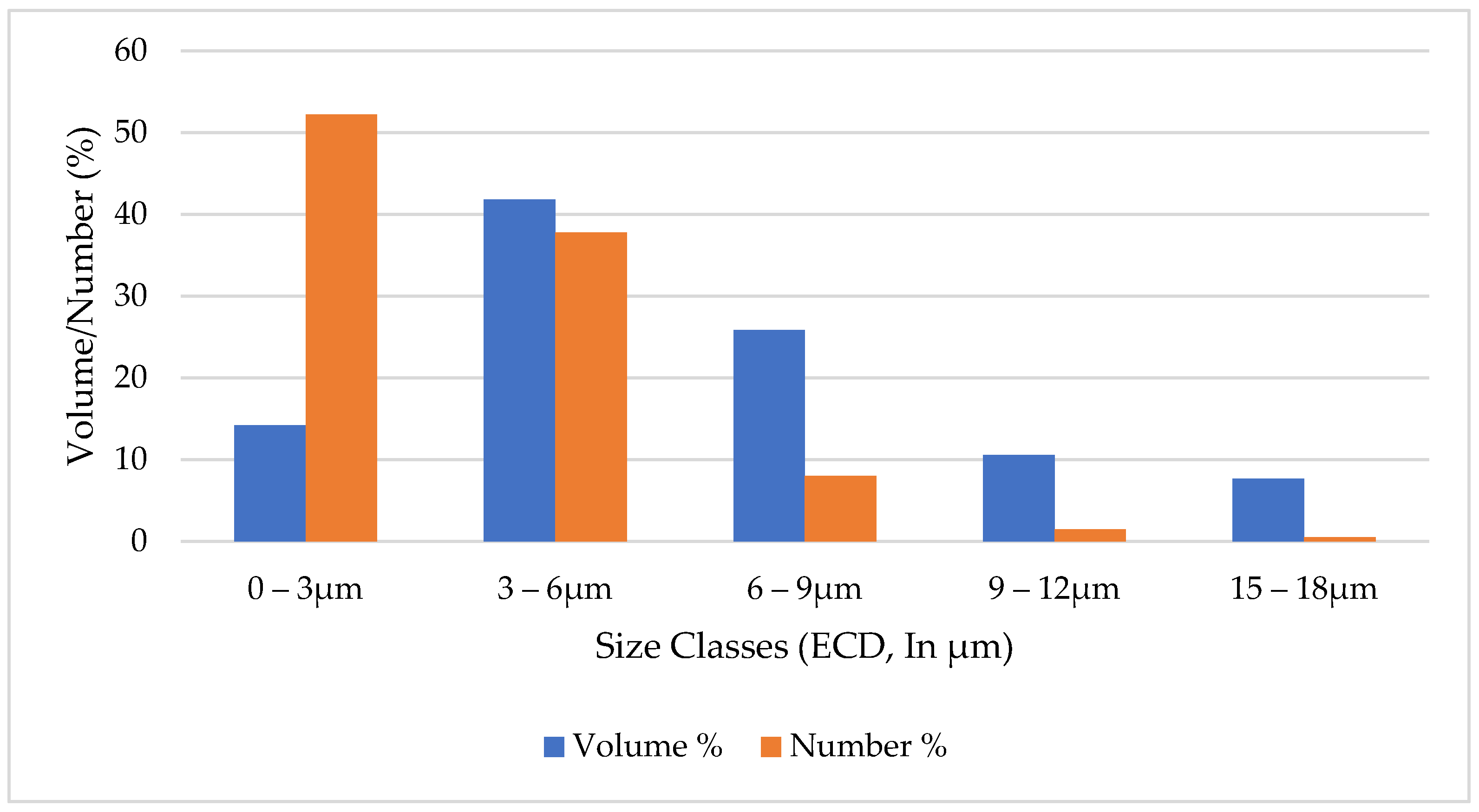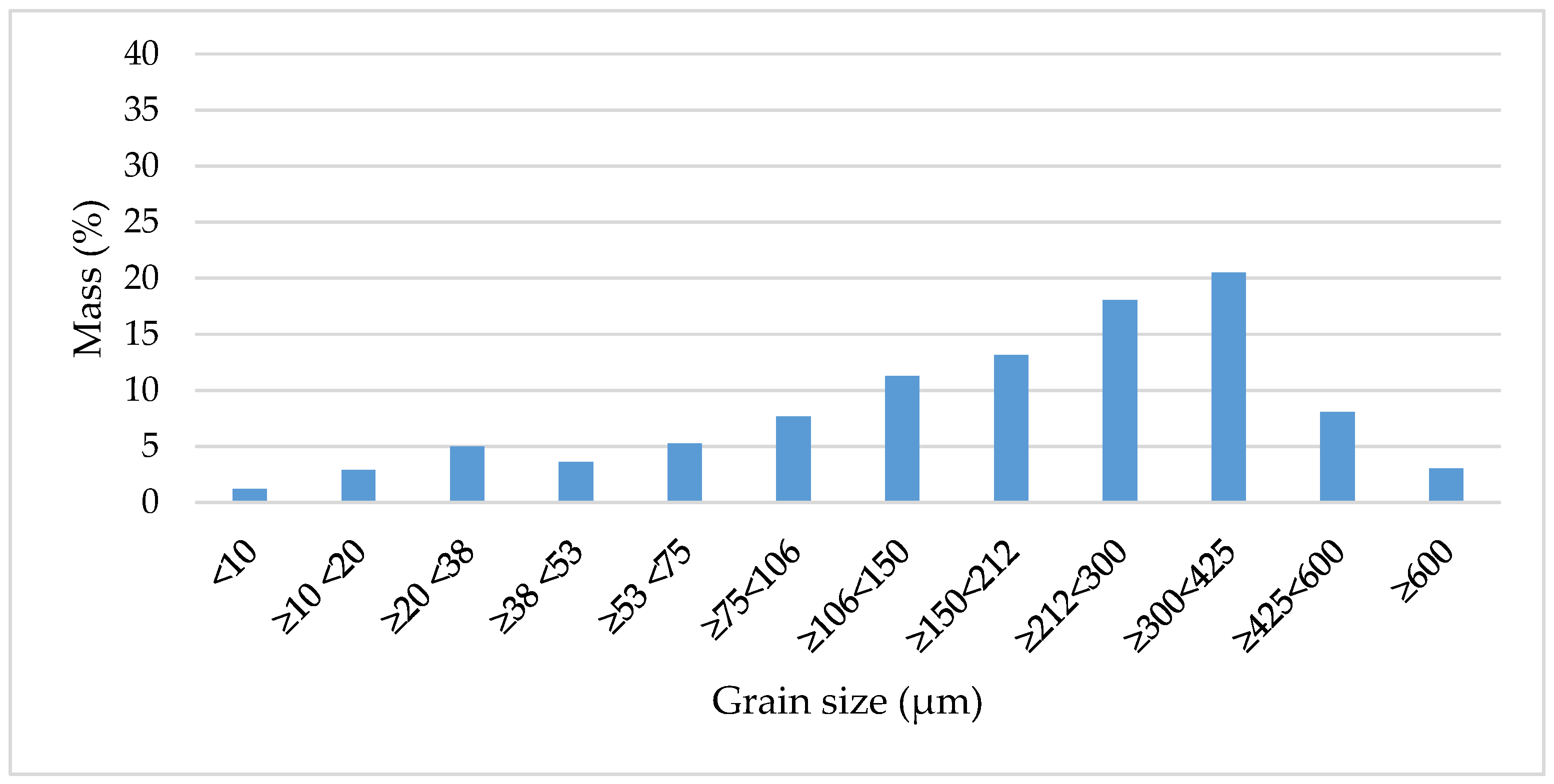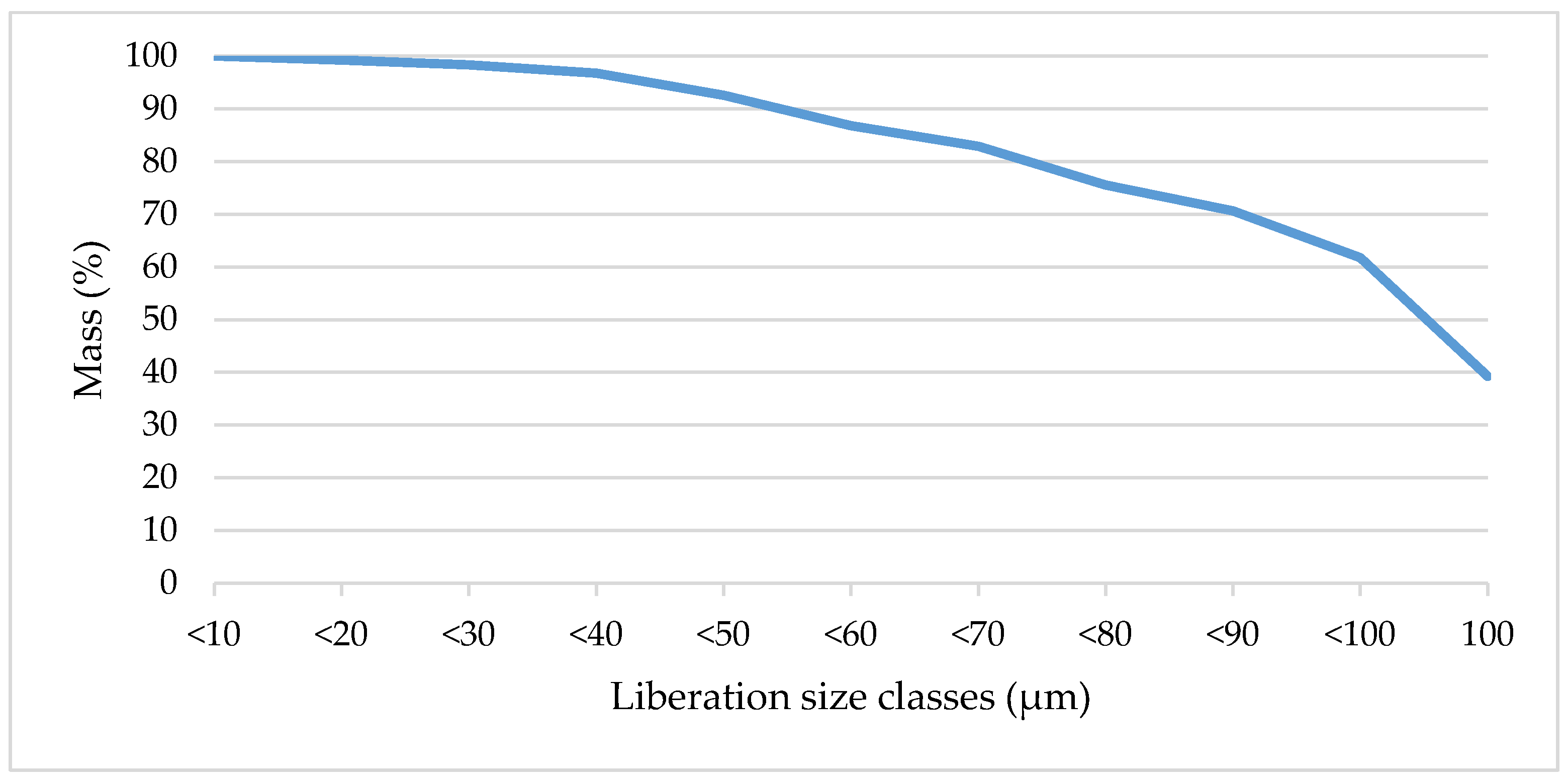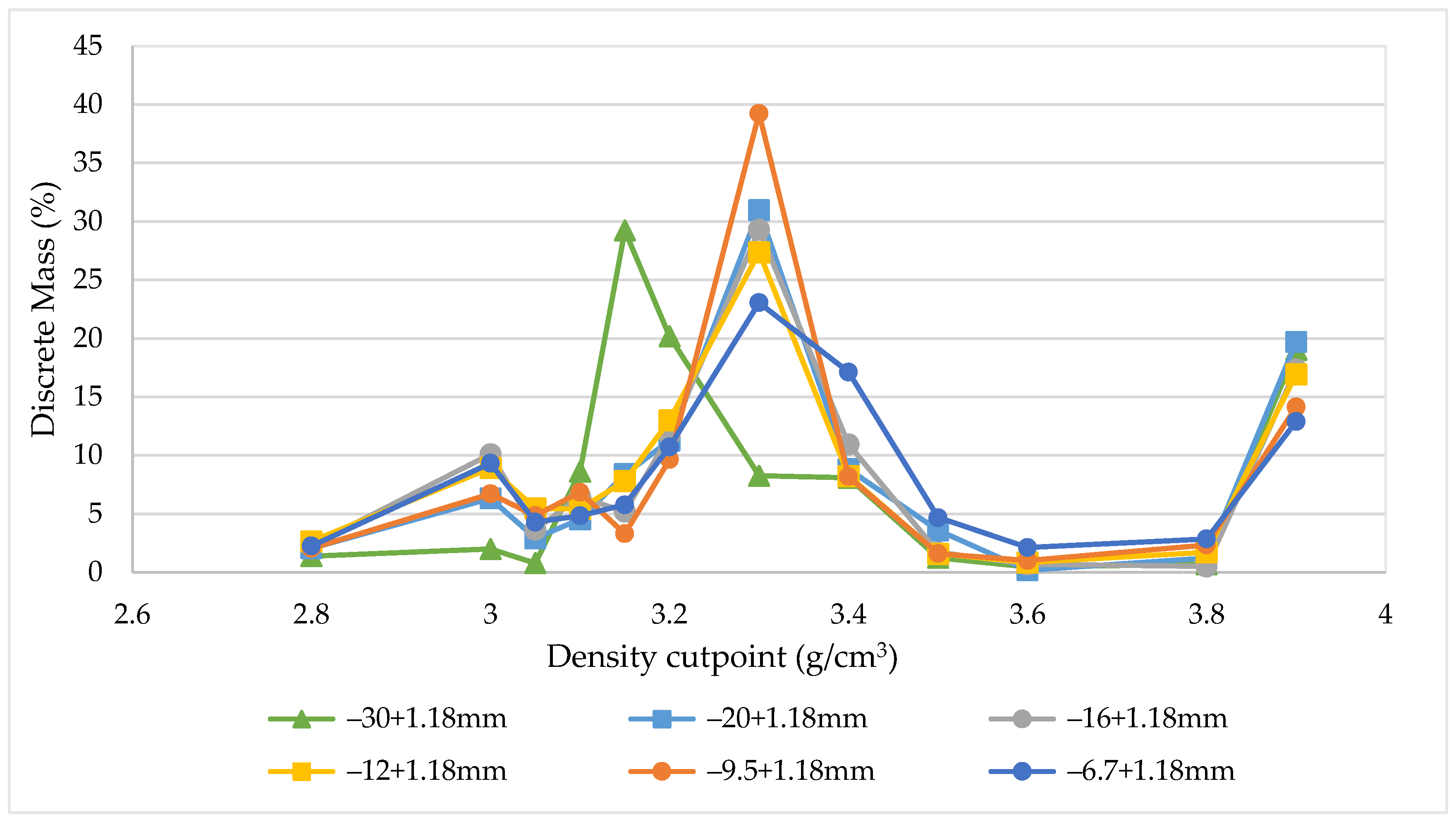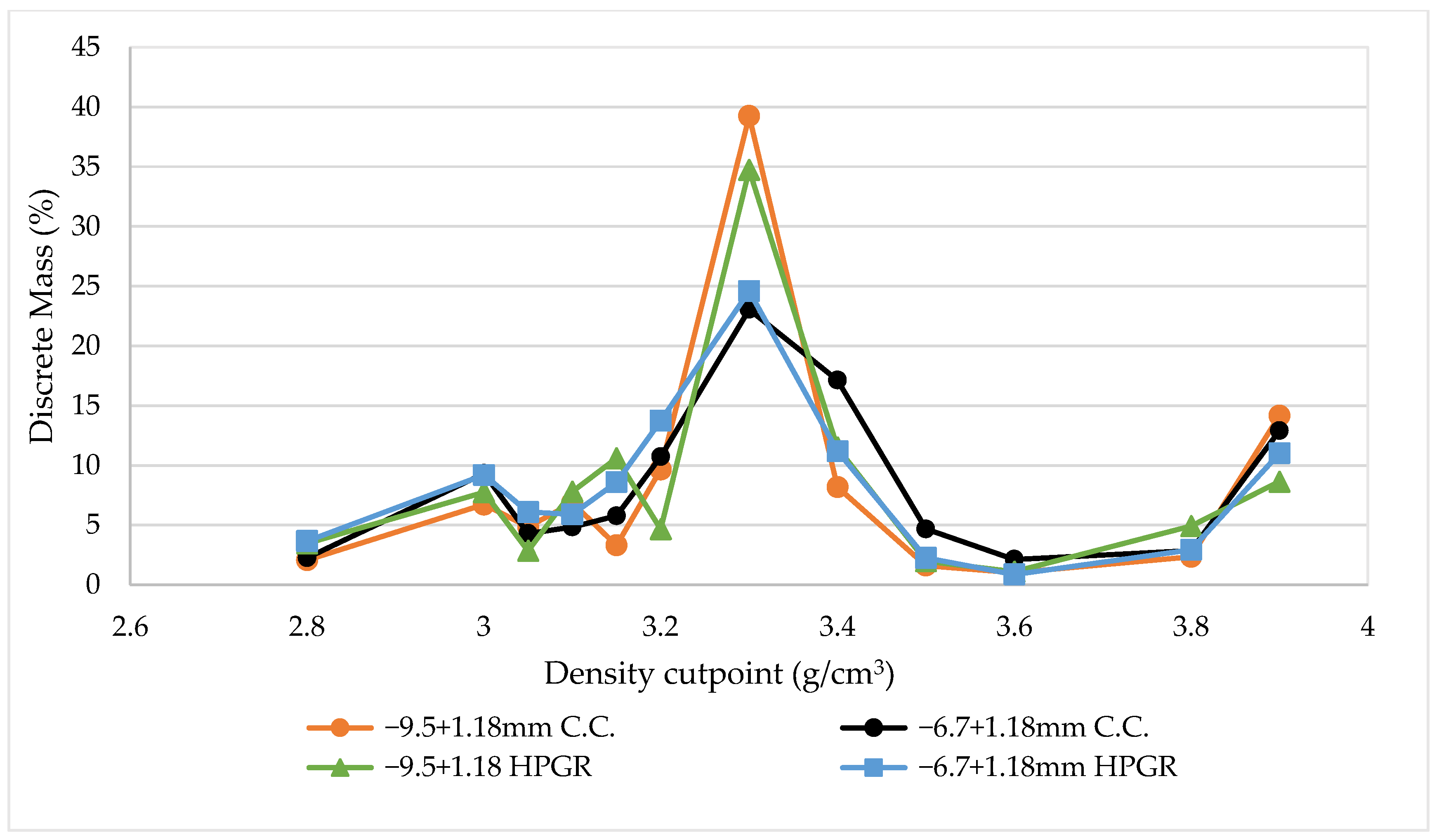1. Introduction
Bushveld Igneous Complex in South Africa is one of the biggest sources of PGMs [
1,
2,
3]. Merensky, UG2, and Platreef are the three principal PGM reefs in the Bushveld Igneous Complex. The three reefs depict different properties because of their mineralogical differences and the PGM head grade [
4,
5]. Comparing the Merensky reef to the UG2 reef, UG2 contains lower quantities of platinum, but higher quantities of palladium and rhodium. UG2 is higher in quantities of small metals such Ruthenium, Iridium, and Osmium [
3]. In 2023–2024 South Africa’s platinum output declined due to high production costs, electricity outages, and low demand. Currently, the prices of PGMs are low due to decreased demands from China and Russia selling PGMs at a discount [
6]. This means the costs of producing PGMs are currently high, and thus to preserve the life of the mine, and save jobs, there is a need to relook at some of the PGMs processing methods to save costs. This includes pre-concentration of low-grade PGMs ores prior to downstream processing to maintain the same head grade to the flotation plant.
For example, pre-concentration of low-grade UG2 ores by dense medium separation (DMS) improves the economics of downstream processing by reducing the power, water, and reagents requirements and increasing the throughput of the Mill-Flotation, Mill-Flotation (MF2) plant. This will further reduce cutoff grade, thus simplifying the mining method and increasing ore reserves [
7]. Other benefits include removal of harder ore minerals such as pyroxenites prior to milling and removal of flotable waste minerals such as talc, which slimes easily during milling, diluting the flotation concentrate [
8]. Previous studies showed that pre-concentration of UG2 ores on crushed −20 mm + 1 mm run of mine (ROM) by dense medium separation (DMS) result in some PGMs losses to the floats [
9]. The current operations using DMS as a pre-concentration stage on a −20 mm + 2 mm crushed run of mine feed reject about 11%–66% mass at 91%–97% PGM recoveries to the sinks. About 5%–15% PGMs are lost to the DMS floats at about 0.3–0.8 g/t grade. Platinum producers regard 5% to more than 10% recovery losses to the floats still high due to the low 4E basket price.
Asakawa [
10] investigated the effect of three crusher mechanisms—jaw, impact, and HPGR—for a pre-concentration process on laboratory dense medium separation, heavy liquid separation (HLS) using three different ores, iron, copper, and polymetallic ores. The impact crusher was found to be the best option for selective comminution on the polymetallic ore, while no differences were observed between the crushers on iron and copper ores [
10]. Recent studies on pre-concentration of PGMs ores by DMS using conventional crushers do not always achieve a DMS overflow with a grade <0.4 g/t. Marape [
9] conducted DMS pre-concentration on size fraction −12 mm + 1 mm of the UG2 ore crushed with conventional crushers, targeting a cut point of 3.3 g/cm
3. The overall mass balance showed that 17.17% of the mass could be rejected with 3.64% of PGMs + Au lost to the floats at a grade of 0.64 g/t PGMs + Au and 1.18% Cr
2O
3, respectively. Although a grade of 0.64 g/t is low, according to industry standards it is not regarded as a discardable PGMs grade. Prior to that, Govender and Gericke [
11] conducted DMS pre-concentration on −20 mm + 2 mm of the UG2 crushed run of mine ore with conventional crushers at a density cut point of 3.7 g/cm
3. The head grade of the feed was 3.46 g/t total PGMs + Au. The grade of the PGMs + Au increased to 4.9 g/t at a mass pull of 39.5% to the sinks. However, the 60.5% of the mass was rejected to the floats at a grade of 1.3 g/t PGMs + Au and 5% Cr
2O
3, which is a significant PGMs loss [
11].
Bergmann [
12] investigated the effect of DMS pre-concentration by comparing the effect of using HPGR as a secondary crusher on DMS floats to conventional crusher. A −20 mm + 1.7 mm fraction of UG2 ore at a grade of 3.46 g/t PGM + Au was crushed with a conventional crusher. The PGMs + Au losses to floats were 11.3%, 7.08%, and 2.16%, respectively, after using DMS [
12]. The floats fractions were further crushed by HPGR using two pressures (15 bar and 30 bar) to liberate chromite and associated PGM into a fine fraction of −1.7 mm and coarse +1.7 mm fraction treated by the DMS. The results show that significant −1.7 mm material generated by the two pressures was enriched in PGMs. The high-pressure condition was more effective in liberating PGMs from the +1.7 mm fraction. In the instance the objective was achieved, however, it is not clear if substituting conventional crushing with HPGR on the feed can improve PGMs liberation to reduce losses to the floats [
12].
The extraction of valuable elements from the UG2 ore using conventional crushers such as Jaw and Cone crushers is energy intensive because of the amount of energy used to grind the ore to liberate fine PGMs grains. With the potential of rejecting gangue prior to the milling and flotation stage, the high-pressure grinding roll (HPGR) developed by Schönert in the 1970s is one such possible device that could achieve liberation of the valuable minerals and allow for efficient dense media separation [
13].
The high-pressure grinding roll (HPGR) utilizes inter-particle crushing, which leads to preferential breakage of softer components. Compared to conventional crushers, they are easy to maintain, consume less energy in the range of 10 to 30% less, and improve mineral liberation due to the pressure of residual micro-cracks in the particles [
14,
15,
16]. The previous study by Nghipulile [
14] showed that sulphides pre-crushed using HPGR depicted a better liberation than those crushed by conventional crushers. However, at finer grind sizes, this advantage was not so apparent.
This study investigated the effect of conventional crushing (Jaw and Cone) and High Pressure Grinding Rolls (HPGR) on the pre-concentration of UG2 ore by DMS to ascertain if the crushing method can minimize PGMs losses to a grade of <0.4 g/t in the DMS float stream. In this paper, the use of High Pressure Grinding Rolls (HPGR) was investigated as an alternative to the conventional crusher methods Jaw and Cone. The majority of UG2 processing plants use DMS as a pre-concentration step due to density difference between chromite (4.6 g/cm
3) and silicates (2.8–3.4 g/cm
3) to produce high PGMs grade sinks product and low-grade float stream [
8].
2. Material and Methodology
2.1. Material
The sample used in this study was a Run of mine (ROM) UG2 ore with a chromite and PGMs head grade of Cr2O3 (10%) and (1.72 g/t), respectively. The sample had a top size of +60 mm.
2.2. Methodology
Figure 1 shows the steps used to prepare the sample before testwork, and
Figure 2 shows the schematic diagram of a flowsheet, which shows the experimental procedure, followed. Each process will be explained separately below:
2.2.1. Sample Preparation and Head Chemical Analysis
Looking at
Figure 1 and
Figure 2, the fresh feed sample (ROM Feed) was stage crushed using a jaw and cone crusher followed by screening depending on the target size fraction. Representative subsamples of the ROM ore crushed to −6.7 mm were further crushed to −1.18 mm and submitted for ore characterization by elemental chemical analysis and mineralogy. Removed subsamples were analysed to determine the deportment of PGMs and major gangue elements. Mineralogy of the sample included PGMs search followed by bulk modal and chromite characterization mineralogy. The purpose of mineralogy investigation was to establish the presence, identity, and relative abundance of PGMs bearing minerals as well as to obtain information on PGMs minerals abundance, deportment, and grain size distribution, liberation, and mineral associations.
Representative subsamples crushed to −30 mm were further stage crushed to −20 mm, −9.5 mm, and −6.7 mm conventional crushing followed by screening at −1.18 mm in preparation for laboratory HLS test. The polysius High pressure grinding roll (HPGR) available at the time of the testwork was limited to a top size of 12 mm. Thus, only two size classes—−9.5 mm and −6.7 mm—could be generated through HPGR followed by screening at 1.18 mm.
Figure 1 shows the schematic diagram of sample preparation that followed.
After the optimum size fraction was selected based on HLS test, the remaining sample was crushed to −20 mm using the jaw crusher followed by screening at 1.18 mm in preparation of the pilot DMS test to produce DMS sinks and floats.
2.2.2. Chemical Analysis
The chemical analysis on the feed and process products were conducted using analysis methods Fire Assay for 4E (PGMS + Au), ICP 21 for low concentrate base metals in solids, and ICP metal oxide in solids.
For fire assay, the sample is fused with a flux in a furnace and the pills are digested on the hot plate to analyze the sample using ICP OES instrument, model 5900 manufactured by Chemtrix BV, Zwolle, The Netherlands. The detection limit of Fire assay for 4E is 0.02 ppm. ICP 21 is used for low base concentrations that cannot be detected by ICP Metal oxides. The methods used for ICP metal oxide and ICP 21 involve mixing the sample with flux, fusing in the autofusion, leaching with water and acid, and analyzing using Agilente ICP OES instrument model 5100 manufactured by Chemtrix BV, Zwolle, The Netherlands. For ICP 21, the sample is digested using four acids. ICP metal oxide has a lower detection limit of 0.05%, after which ICP 21 will be employed, which has a lower detection limit of 10 ppm.
2.3. Mineralogical Analysis
2.3.1. PGM Search
The sample was representatively sub-sampled and screened to produce polished mounts for analysis by the AutoSEM—using the FEG Mineral Liberation Analyzer (MLA) platform. The FEG MLA used was 650F model, with a detection limit of 0.05%. The analysis was based on a bright phase search, which searches out platinum group metals (PGM) based on their higher backscattered electron intensity under the electron beam, compared with gangue minerals. The bright phase, along with any other phases in the particle in which it occurs, was mapped using image analysis software. The bright PGMs were identified through the setting up of a standards library and described in terms of the species present and their relative abundance, grain size distributions, liberation characteristics, and mineral associations (i.e., what other minerals are associated with the identified PGM grains in particles). The PGM search analyses provided PGM species identification, grain size distribution, liberation characteristics, and gangue associations of PGM-bearing particles detected in the sample.
2.3.2. Bulk Modal
Representative polished sections of the sample were prepared for analysis by QEMSCAN AutoSEM platform. The sizing of the sample provides better accuracy of results from the QEMSCAN system.
Quantitative mineralogical assessment was conducted using a FEQ Qemscan 650F instrument manufactured by Field Electron and Ion Company, Hillsboro, OR, USA. The instrument uses backscattered electron (BSE) and energy-dispersive X-ray (EDX) signals from a scanning electron microscope (SEM) to create digital images in which each pixel corresponds to mineral species in the corresponding region under the electron beam. The analysis was carried out using the Particle Mineral Analysis (PMA) measurement mode. The particle mineralogical analysis (PMA) mode was used to provide information on the bulk modal mineral proportions by locating and identifying all the mineral phases present in the sample using a relevant SIP (Species Identification Protocol) composed of pre-defined compositions and BSE criteria. Combination of iDiscover and iMeasure software (version 5.2.3.2) were employed for the analysis. The Qemscan technique provides quantitative bulk mineralogy data, liberation, grain size distribution, and mineral association of the mineral of interest. The detection limit of this technique is approximately 0.05 mass percentage.
2.4. Heavy Liquid Separation (HLS)
Laboratory HLS testwork depicted in
Figure 3 was conducted to determine if the UG2 ore was suitable for pre-concentration using dense media separation. HLS allows the separation of the feed into different density fractions providing insight into the recovery and gangue rejection at different density cut points [
17]. It is fast and inexpensive and provided optimum cut density for pilot scale DMS processing. Tests were conducted on size classes −30 + 1.18 mm, −20 + 1.18 mm, −16 + 1.18 mm, −12.5 + 1.18 mm, −9.5 + 1.18 mm, and −6.7 + 1.18 mm fractions crushed using conventional crushing and two fractions crushed by High Pressure Grinding Rolls (HPGR), the −9.5 + 1.18 mm and −6.7 + 1.18 mm fractions.
HLS tests were conducted on an array of density cut points ranging from 2.8 g/cm3 to 3.8 g/cm3 to determine the optimum cut density for maximum waste rejection at minimum PGMs losses to the floats. This was conducted to characterize the feed, determine the washability size fraction, and type of crusher that will minimize PGMs losses during DMS processing. The selection of the optimum size fraction was dependent on the grade, recovery, and mass yield that will limit PGMs losses to floats to a grade equal to and less than 0.4 g/t. Results from HLS were used to generate washability curves used to determine the DMS response profile confirming the optimum DMS cut point to reject barren waste.
2.5. Pilot Dense Medium Separation Testwork
A representative ROM feed sample was crushed using conventional crushing—i.e., jaw and cone crusher—depending on the size fraction for DMS testwork as it was deemed optimum compared to HPGR under the conditions tested. HLS results were used to determine the optimum cut point, size class, and crushing method. Pilot DMS was conducted using Mintek Pilot DMS cyclone facility (refer to
Figure 4), 350 mm diameter cyclone at a feed pressure of 80 kPa and feed density of 3.4 g/cm
3 for size class −20 + 1.18 mm.
Coarse atomised FeSi 270D powder supplied by DMS Powders, Vereeniging, South Africa was employed. Circulating density, cyclone underflow and overflow densities, and feed pressure were monitored during operation to ensure steady conditions and constant feed. Once operating parameters meet optimum conditions, overflow and underflow products were collected, sun dried, and weighed.
10 kg sub-samples of float and sink products were prepared using riffle splitter for HLS and chemical analysis. HLS products were dried and weighed. The masses obtained were used to generate a tromp curve to determine the Ecart Probable (EP), used to measure cyclone efficiency.
5. Dense Medium Separation (DMS)
Pilot DMS testwork was conducted on crushed and screened −20 + 1.18 mm fraction prepared by conventional crusher. The testwork was conducted using milled 270D Ferrosilicon to target a cut point of 3.4 g/cm
3.
Table 5 shows pilot DMS test conditions employed.
The overall recovery of Total PGMs + Au to the DMS sinks and the −1.18 mm fines was approximately 84.96% (refer to
Table 6). In overall, the DMS cyclone could reject 61.1% mass to the floats based on ROM at 1.12% Cr
2O
3 and 0.42 g/t Total PGMs + Au grade at 15.04% of the Total PGMs + Au recovery losses. Compared to the testwork conducted by Marape [
9], Govender and Gericke [
11] at Mintek, the grade is discardable (approximately 0.4 g/t) at no cost and a higher mass yield to the floats.
Subsamples of −20 + 1.18 mm DMS floats and sinks products from the pilot DMS testwork were subjected to HLS testwork to determine the separation efficiency and actual density cut point attained on the pilot DMS run.
Table 7 shows the actual SG
50 cut point achieved as well as the Ecart Probable (Ep) obtained from the partition curve.
The partition profile of the DMS plant run (Tromp curve) suggested that the actual density cut point obtained during the pilot DMS run on material using milled 270D FeSi was 3.46 g/cm
3 at Ep of 0.04. The actual cut point and overall mass split to the floats was higher than that targeted based on the HLS test.
Table 8 compares DMS mass yield to floats at 3.46 g/cm
3 to HLS. Results show that DMS reported a 2% mass yield slightly lower than predicted by HLS at a density of 3.46 g/cm
3 but similar to density 3.40 g/cm
3 from the heavy liquid separation. Compared to Marape [
9], the DMS reported a 3% mass yield slightly lower than predicted by heavy liquid separation.
